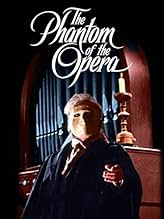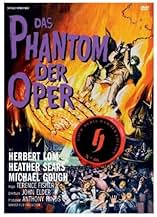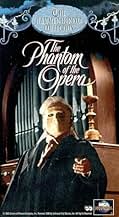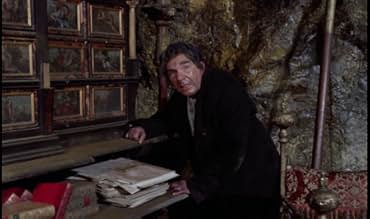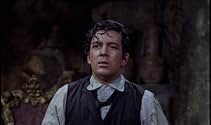IMDb RATING
6.4/10
4K
YOUR RATING
An acid-scarred composer has his dwarf helper bring an opera singer to his London sewer hide-out.An acid-scarred composer has his dwarf helper bring an opera singer to his London sewer hide-out.An acid-scarred composer has his dwarf helper bring an opera singer to his London sewer hide-out.
- Awards
- 1 nomination total
Miriam Karlin
- Charwoman
- (as Miriam Carlin)
- Director
- Writers
- All cast & crew
- Production, box office & more at IMDbPro
Featured reviews
Though this version strays quite far from the book, it was still very good. Herbert Lom and Micheal Gough are excellent in this film, and the Dwarf was an odd, but fun twist. I didn't think that Miss Sears was right for Christine, but she did well none the less. All in all, pretty scary for the time and a good watch. I suggest it be watched, provided of course you can find it.
Gaston Leroux's classic novel, "The Phantom of the Opera", is definitely one of the most famous and influential Gothic stories of horror and mystery ever written, and its main character, the Phantom, an icon of the Gothic horror literature. The novel's enormous popularity has resulted in many different adaptations, such as the 1925 silent film starring Lon Chaney, or more recently, the musical play by Andrew Lloyd Webber; works where the story of the mysterious figure that haunts the Palais Garnier has been explored in many different and interesting ways. Given the potential of the story, it's not a surprise that the legendary production company, Hammer Films, decided to make its own version of the story, written and produced by Anthony Hinds and under the direction of Hammer's best filmmaker Terence Fisher.
Hammer's version offers many changes to Leroux's novel, the most noticeable one being that the movie is set in London instead of Paris. In this movie, producer Harry Hunter (Edward De Souza) and theater owner Lattimer (Thorley Walters) are working with famous composer Lord Ambrose d'Arcy (Michael Gough) to put d'Arcy's new opera, "Joan of Arc", on stage. However, they are facing trouble as a mysterious figure known only as "the Phantom" (Herbet Lom) is wrecking havoc by sabotaging the essays and committing a series of murders. The Phantom's actions make the lead singer of the opera to quit, but soon the producers find a replacement in the figure of Christine Charles (Heather Sears), a young singer with a beautiful voice. However, the Phantom is still there, and he gets a sudden dangerous interest in the new singer.
Written by producer Anthony Hinds (as usual, under the pen name of John Elder), this version of the Phantom's story is a complete re-imagining of Leroux's story; but while different, it remains surprisingly faithful to the novel's essence by keeping true to the horror and mystery elements of the story. The Phantom here is a sympathetic and human figure, pretty much like the one presented in Universal's 1943 adaptation; however, Hinds makes his Phantom an anti-hero, and together with the addition of Lord d'Arcy as another "villian" gives the movie a very different tone to that previous version. As in most of his works, Hinds plays with the tragic aspects of horror, slowly taking the story to its shocking (albeit rushed) ending.
Director Terence Fisher makes an excellent job at bringing this Phantom to life with his usual lavish look and with a nice touch of class and elegance. Hammer horror movies are known for being violent and gory, but this movie is different in the sense that focuses on atmosphere and mood rather than on scares. In fact, while the Phantom has a striking appearance (courtesy of Roy Ashton's excellent make-up), Fisher subtle and restrained take makes him less scary, using the haunting presence of his "monster" to increase its tragedy, instead of his monstrosity. While the budget was low, Fisher makes great use of his resources to create a wonderful moody film that keeps the novel's captivating atmosphere like few adaptations have done.
Another element that makes "The Phantom of the Opera" an unusual Hammer film is the fact that few Hammer regulars appear in the cast. However, this by no means is a sign of unworthy performances. Herbert Lom is excellent as the Phantom, a difficult role as the mask in Fisher's version covers completely the actor's face, forcing him to use only his voice in his delivery. Lom is no Chaney of course, but easily ranks as the second best performance as the character. Edward De Souza's character is an equivalent of the novel's Raoul, but of course, with a big number of changes. De Souza's Harry Hunter is daring and witty, and he carries the film with dignity as the character in charge of solving the mystery of the Opera House. Heather Sears makes a believable Christine with her innocent looks and an excellent lip sync for the singing scenes. Finally, Michael Gough steals the movie, making a terrific performance as the villainous Lord d'Arcy; easily, the highlight of the movie.
It's easy to see why this version of "The Phantom of the Opera" is not as celebrated as other Hammer films. The movie lacks some of the studio trademarks, as Hinds and Fisher decided to go for a different approach in this film. Also, the focus on atmosphere and mystery instead of direct horror make the film to look "different" or atypical, however, it's this restrained approach what in the end makes it one of the best (and ironically most faithful) adaptations of the story. At first sight it feels as if the Hammer magic was lost, but in the end, this is far from the worst that the legendary studio has done, and in all fairness, it's as good as their best films. Finally, a last minor quibble is that, like the 1943 film, it uses many overlong Opera scenes that while remarkably well done, add little to the plot and easily could had been replaced with a longer conclusion.
"The Phantom of the Opera" is not really a favorite among Hammer fans, but it's a really classy take on the iconic story of the disfigured genius that roams the Opera house. It's very different to other versions, but it keeps the spirit of Leroux's novel like no other film has done (with the exception of 1925 silent film). This underrated film really deserves a chance to be better known. 7/10
Hammer's version offers many changes to Leroux's novel, the most noticeable one being that the movie is set in London instead of Paris. In this movie, producer Harry Hunter (Edward De Souza) and theater owner Lattimer (Thorley Walters) are working with famous composer Lord Ambrose d'Arcy (Michael Gough) to put d'Arcy's new opera, "Joan of Arc", on stage. However, they are facing trouble as a mysterious figure known only as "the Phantom" (Herbet Lom) is wrecking havoc by sabotaging the essays and committing a series of murders. The Phantom's actions make the lead singer of the opera to quit, but soon the producers find a replacement in the figure of Christine Charles (Heather Sears), a young singer with a beautiful voice. However, the Phantom is still there, and he gets a sudden dangerous interest in the new singer.
Written by producer Anthony Hinds (as usual, under the pen name of John Elder), this version of the Phantom's story is a complete re-imagining of Leroux's story; but while different, it remains surprisingly faithful to the novel's essence by keeping true to the horror and mystery elements of the story. The Phantom here is a sympathetic and human figure, pretty much like the one presented in Universal's 1943 adaptation; however, Hinds makes his Phantom an anti-hero, and together with the addition of Lord d'Arcy as another "villian" gives the movie a very different tone to that previous version. As in most of his works, Hinds plays with the tragic aspects of horror, slowly taking the story to its shocking (albeit rushed) ending.
Director Terence Fisher makes an excellent job at bringing this Phantom to life with his usual lavish look and with a nice touch of class and elegance. Hammer horror movies are known for being violent and gory, but this movie is different in the sense that focuses on atmosphere and mood rather than on scares. In fact, while the Phantom has a striking appearance (courtesy of Roy Ashton's excellent make-up), Fisher subtle and restrained take makes him less scary, using the haunting presence of his "monster" to increase its tragedy, instead of his monstrosity. While the budget was low, Fisher makes great use of his resources to create a wonderful moody film that keeps the novel's captivating atmosphere like few adaptations have done.
Another element that makes "The Phantom of the Opera" an unusual Hammer film is the fact that few Hammer regulars appear in the cast. However, this by no means is a sign of unworthy performances. Herbert Lom is excellent as the Phantom, a difficult role as the mask in Fisher's version covers completely the actor's face, forcing him to use only his voice in his delivery. Lom is no Chaney of course, but easily ranks as the second best performance as the character. Edward De Souza's character is an equivalent of the novel's Raoul, but of course, with a big number of changes. De Souza's Harry Hunter is daring and witty, and he carries the film with dignity as the character in charge of solving the mystery of the Opera House. Heather Sears makes a believable Christine with her innocent looks and an excellent lip sync for the singing scenes. Finally, Michael Gough steals the movie, making a terrific performance as the villainous Lord d'Arcy; easily, the highlight of the movie.
It's easy to see why this version of "The Phantom of the Opera" is not as celebrated as other Hammer films. The movie lacks some of the studio trademarks, as Hinds and Fisher decided to go for a different approach in this film. Also, the focus on atmosphere and mystery instead of direct horror make the film to look "different" or atypical, however, it's this restrained approach what in the end makes it one of the best (and ironically most faithful) adaptations of the story. At first sight it feels as if the Hammer magic was lost, but in the end, this is far from the worst that the legendary studio has done, and in all fairness, it's as good as their best films. Finally, a last minor quibble is that, like the 1943 film, it uses many overlong Opera scenes that while remarkably well done, add little to the plot and easily could had been replaced with a longer conclusion.
"The Phantom of the Opera" is not really a favorite among Hammer fans, but it's a really classy take on the iconic story of the disfigured genius that roams the Opera house. It's very different to other versions, but it keeps the spirit of Leroux's novel like no other film has done (with the exception of 1925 silent film). This underrated film really deserves a chance to be better known. 7/10
The novel The Phantom of the Opera has been filmed at least ten times plus now. This entry by Hammer Studios is one of the better ones, bringing a liberal change in storytelling as well as some very atmospheric settings and camera work. Directed by Terence Fisher, this film, like Fisher's The Gorgon, is highly poetic. The phantom is a former music professor who has been pushed into his life of seclusion and physical deformity. He is a figure of sympathetic pity rather than horror. It is this point of view which makes this film very interesting as the phantom is not the monster but rather just a man who has been mistreated trying to cope and resurrect his life. Yep, he still lives in the sewers of Paris. The Hammer sets are wonderful all around, particularly the opera house and the winding underground sewers. Hammer also puts their stamp of luxuriant looking cinematography on. Herbert Lom plays the man behind the mask. Lom does a nice job in the film as do all the leads. Heather Sears is a striking heroine, and Edward Da Souza makes an affable leading man. The real star, apart from Fisher's direction, is Michael Gough. Boy, can this man play a mean individual. Gough's screen time is magic as he malevolently belittles everyone around him, steals things that are not his, and lewdly leers at anything in a skirt! The film also boasts some fine staged opera numbers and a beautiful soundtrack. Many scenes show Fisher's competence and ability to create lush moods whilst being able to provide good storytelling.
A fine Phantom edition.
A fine Phantom edition.
As far as adaptations of The Phantom of the Opera goes(excluding the Andrew Lloyd Webber musical), this 1962 Hammer version is not as good as Lon Chaney's, which is the best version, but it's superior to the Claude Rains version(though I do prefer Rains over Herbert Lom).
It does have its problems, with too much time spent on the opera and the romance and not enough of the Phantom, which does undermine the tension, sense of dread and horror. Sadly, the opera numbers, while musically good, are staged awkwardly and really do slow the film down. The romance is rather saccharine, and the chemistry between the two 'heroes' a little bland. Heather Sears also plays Christine too low-key and the script, while with some intelligent moments, does plod sometimes and has a little too much talk.
However, it is very lavishly made (one of the better looking early-60s Hammer films) with truly marvellous interiors of the opera house, rich vibrant colours and opulent costumes. It is beautifully and spine-chillingly scored, though James Bernard would have been an even better fit for composer. The story is less than perfect, but does offer some effective moments. The close up of the eye is really quite chilling and enough to make one jump, while the grasping hand over the stage and the lowering of the gas lamp are indeed very suspenseful, Phantom's back-story is interesting and makes one empathise with him and the ending is incredibly moving.
Terrence Fisher's direction is technically accomplished and does evoke some suspense and atmosphere, though his story-telling has been better elsewhere. Regarding the acting, Michael Gough steals the show being chillingly vile as a true slimeball with no redeeming qualities of a character. Herbert Lom is a great contrast as the Phantom, under heavy and effective make-up he is a sympathetic and tragic figure and it is quite a poignant performance, though not without a few scary moments. Edward De Souza is charming.
In conclusion, not among the best of Hammer by a long shot and could have been better, but still manages to be pretty good. 7/10 Bethany Cox
It does have its problems, with too much time spent on the opera and the romance and not enough of the Phantom, which does undermine the tension, sense of dread and horror. Sadly, the opera numbers, while musically good, are staged awkwardly and really do slow the film down. The romance is rather saccharine, and the chemistry between the two 'heroes' a little bland. Heather Sears also plays Christine too low-key and the script, while with some intelligent moments, does plod sometimes and has a little too much talk.
However, it is very lavishly made (one of the better looking early-60s Hammer films) with truly marvellous interiors of the opera house, rich vibrant colours and opulent costumes. It is beautifully and spine-chillingly scored, though James Bernard would have been an even better fit for composer. The story is less than perfect, but does offer some effective moments. The close up of the eye is really quite chilling and enough to make one jump, while the grasping hand over the stage and the lowering of the gas lamp are indeed very suspenseful, Phantom's back-story is interesting and makes one empathise with him and the ending is incredibly moving.
Terrence Fisher's direction is technically accomplished and does evoke some suspense and atmosphere, though his story-telling has been better elsewhere. Regarding the acting, Michael Gough steals the show being chillingly vile as a true slimeball with no redeeming qualities of a character. Herbert Lom is a great contrast as the Phantom, under heavy and effective make-up he is a sympathetic and tragic figure and it is quite a poignant performance, though not without a few scary moments. Edward De Souza is charming.
In conclusion, not among the best of Hammer by a long shot and could have been better, but still manages to be pretty good. 7/10 Bethany Cox
I have many other "Phantom" movies but this is one of my favorites, even though the location and story has been changed. I thought Herbert Lom did a great job and the aria Christine sings is hauntingly beautiful. I would love to have a CD of the music. Does anyone know if it is available?
Did you know
- TriviaThe "London Opera House" used here is actually the Wimbledon Theatre.
- GoofsA boom crane is visible in Christine's dressing room mirror briefly when the Phantom first speaks to her.
- Quotes
Harry Hunter: What I don't understand is how Ambrose d'Arcy can write so much excellent music in the last few years when he has so little musical taste.
- Alternate versionsThe UK cinema version was cut by the BBFC for an 'A' (PG) certificate and edited the eye-stabbing of the rat-catcher and shots of a hanging body, as well as extensive edits to scenes showing the creation and final unmasking of the Phantom. Later video and DVD releases were uncut.
- ConnectionsFeatured in The Movie Orgy (1968)
- SoundtracksJoan of Arc
by Edwin Astley
Details
- Release date
- Country of origin
- Language
- Also known as
- El fantasma de la ópera
- Filming locations
- New Wimbledon Theatre, The Broadway, Wimbledon, London, England, UK(Theatre Auditorium Interiors)
- Production company
- See more company credits at IMDbPro
Box office
- Budget
- £180,000 (estimated)
- Runtime
- 1h 30m(90 min)
- Aspect ratio
- 1.66 : 1
Contribute to this page
Suggest an edit or add missing content


